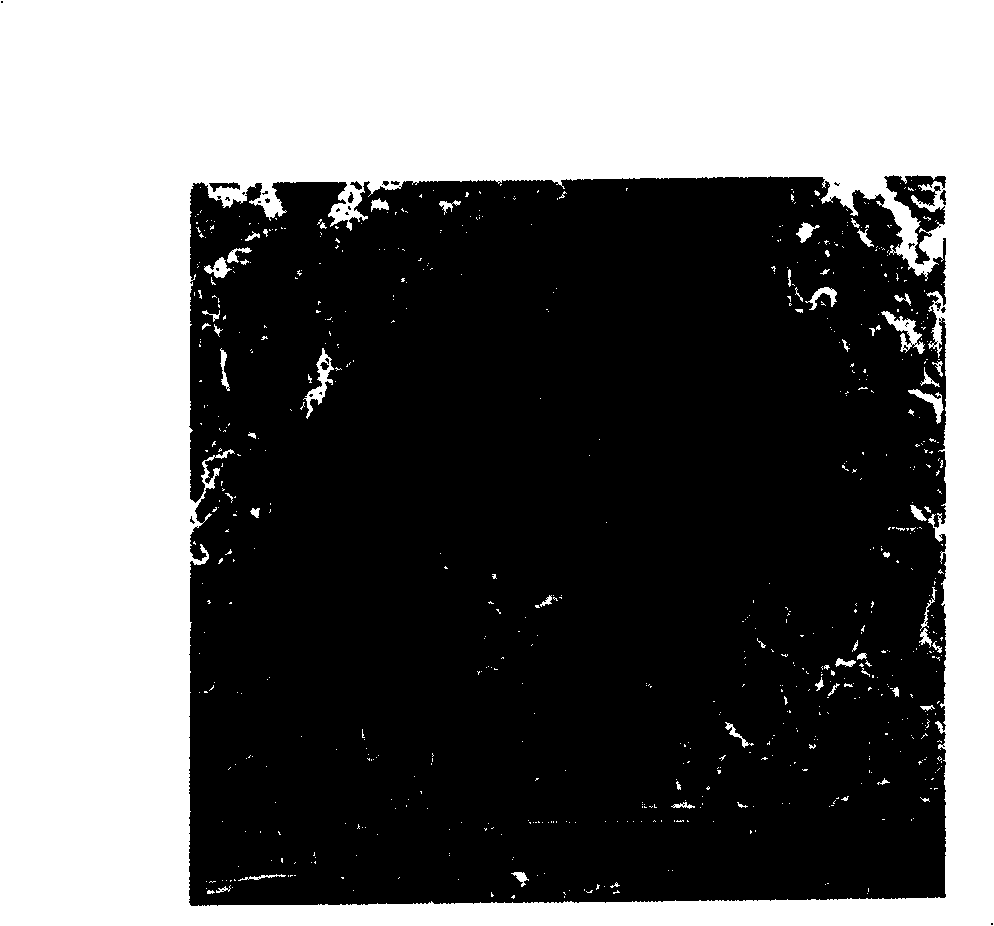Method for preparing chitosan or/and gelatin-polylacticacid polymer blend three-dimensional porous stent
A three-dimensional porous chitosan technology, applied in medical science, prosthesis, etc., can solve the problems of uneven structure and difficult stability of the blend, and achieve strong connectivity, good biocompatibility and degradability, Effects from a wide range of sources
- Summary
- Abstract
- Description
- Claims
- Application Information
AI Technical Summary
Problems solved by technology
Method used
Image
Examples
Embodiment 1
[0016] Add 1.8182g of poly DL-lactic acid into 16ml of chloroform, stir to dissolve it. After the dissolution is complete, add 0.0606g chitosan and 0.1212g gelatin and mix well. Add 4g of sodium polyphosphate and 4g of sodium chloride and stir evenly, wherein the particle size range of sodium polyphosphate and sodium chloride is between 50 and 200 microns. When the chloroform is volatilized until the system becomes viscous, the mixed system is cast into a preset hydrophobized glass mold for molding. The molded solid was taken out from the mold, put into a vacuum drying oven, and further dried at room temperature and 0.1 MPa for 48 hours. The solid was taken out, placed in an acetic acid solution with a mass concentration of 2%, and gently shaken at a constant temperature for 96 hours at a temperature of 37°C. The solid was taken out and placed in deionized water. After repeated washing for 20 times, no sodium chloride was detected in the washed deionized water, and a wet ste...
Embodiment 2
[0018] Add 0.6667 g of poly-L-lactic acid to 9 ml of dichloromethane, and stir to dissolve it. After the dissolution is complete, add 0.1111g chitosan and 0.2222g gelatin, and mix well. Add 4g of sodium polyphosphate and 4g of potassium chloride and stir evenly, wherein the particle size range of sodium polyphosphate and potassium chloride is between 50 and 200 microns. When the dichloromethane volatilizes until the system becomes viscous, the mixed system is cast into a preset hydrophobized glass mold for molding. The molded solid was taken out from the mold, put into a vacuum drying oven, and further dried at room temperature and 0.1 MPa for 24 hours. Take out the solid, place it in a solution with a mass concentration of 1% acetic acid and a mass concentration of 5% sodium polyphosphate, and shake gently at a constant temperature for 48 hours under the condition of 37°C. The solid was taken out and placed in deionized water, and the water was changed every 12 hours. After...
Embodiment 3
[0020] Add 0.7692g of poly DL-lactic acid into 8ml of chloroform, and stir to dissolve it. After the dissolution is complete, add 0.2308g chitosan and mix well. Add 2g of sodium polyphosphate and 2g of sodium chloride and stir evenly, wherein the particle size range of sodium polyphosphate and sodium chloride is between 50 and 200 microns. When the chloroform is volatilized until the system becomes viscous, the mixed system is cast into a preset hydrophobized glass mold for molding. The molded solid was taken out from the mold, put into a vacuum drying oven, and further dried at room temperature and 0.06MPa for 24 hours. Take out the solid, place it in a solution with a mass concentration of 2% acetic acid and a mass concentration of 4% sodium polyphosphate, and shake gently at a constant temperature for 48 hours under the condition of 37°C. The solid was taken out and placed in deionized water, and the water was changed every 12 hours. After repeated washing for 10 times, t...
PUM
| Property | Measurement | Unit |
|---|---|---|
| particle diameter | aaaaa | aaaaa |
| particle diameter | aaaaa | aaaaa |
| particle diameter | aaaaa | aaaaa |
Abstract
Description
Claims
Application Information
 Login to View More
Login to View More - R&D
- Intellectual Property
- Life Sciences
- Materials
- Tech Scout
- Unparalleled Data Quality
- Higher Quality Content
- 60% Fewer Hallucinations
Browse by: Latest US Patents, China's latest patents, Technical Efficacy Thesaurus, Application Domain, Technology Topic, Popular Technical Reports.
© 2025 PatSnap. All rights reserved.Legal|Privacy policy|Modern Slavery Act Transparency Statement|Sitemap|About US| Contact US: help@patsnap.com

